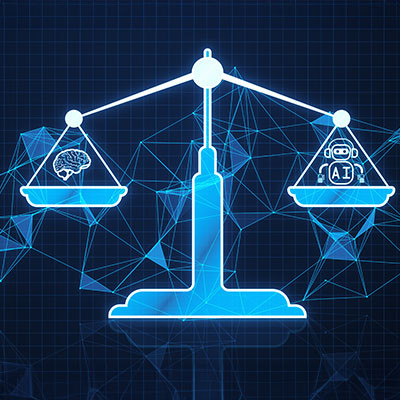Telesys Voice and Data Blog
Big data has become an invaluable asset, not just for large corporations but also for small businesses. Using the vast amounts of data your business creates to help you make more effective decisions is easier than ever. In this month’s newsletter, we’ll look at how small businesses are tapping into the power of big data:
Every business is looking to technology to enhance their ability to support their operations and provide a better customer experience. Maximizing the value you get from your technology involves a combination of optimizing usage, staying updated, and using the tools and resources you’ve chosen efficiently. Here are some strategies:
More small and medium-sized businesses than ever are seeing AI's potential to transform their operations. However, like any technology, AI has its own set of pros and cons. Let's discuss three major advantages and drawbacks you can expect if using it in your business. Hopefully, it helps you make an informed decision about adopting AI.
Firewalls are a mainstay of network security. At its core, the firewall acts as a barrier between a trusted internal network and untrusted external networks, such as the Internet. Its primary function is to monitor and control incoming and outgoing network traffic based on predetermined security rules. Think of the firewall as a gatekeeper scrutinizing every packet of data that attempts to pass through. Let’s take a look at the different types of firewalls and some of their key functions.
Most businesses need to confront IT innovation, as technology moves pretty fast. If you don’t have a plan to at least consider the technology, you could be easily left in the dust. In this month’s newsletter, we will discuss some pretty transformative technologies that are evolving quickly and can help your business improve its overall innovation.
You’ve probably heard of augmented reality by now. If you are a fan of sports on TV, especially. Every time your favorite team faces a 4th and 1, the lines that you may take for granted on the field is AR. It augments the image with overlays of information that makes what you are looking at more immersive. As businesses continue to evolve, integrating augmented reality can be a game-changer. Let's explore four compelling ways in which augmented reality can work wonders for businesses.
The web is filled with all types of content, and depending on where you live, it can be regulated by a myriad of organizations from all sections of society. From internationally recognized trade organizations to governments to industry regulators, there are a lot of moving parts in data regulation as it now stands. That leads to people wanting more control over data and censorship. Let’s take a look at cyber censorship and how it's a bigger issue than you might think.
While it’s true that technology has become essential for businesses, organizations still often grapple with various technology issues that can impact how they do business. Many times organizations get turned around and it can cause some aspect of their IT to be problematic for them. Today, we look at five common technology issues that businesses frequently face.
Effectively managing the multitude of devices in a contemporary office is a big job. The challenge lies in meticulous oversight of each device, identifying users, and observing patterns of usage. If your technology assets are not currently being tracked, it is a good idea to implement some way of monitoring those systems. The adoption of an inventory management system presents a more efficient and streamlined approach to address this challenge.
We’re at a weird point in the technology world (but honestly, when is it not at least a little convoluted?). Right now, modern technology has been slowly shifting between a few different technologies and consumers and businesses are stuck in the middle trying to figure out what to do and how to future-proof their hardware investments.
Businesses need money to operate and sometimes it can be awfully difficult to find enough financial wiggle room to do the things that you want to do after all the bills are paid. Finding the right technology can help. By building a more efficient business, tasks take fewer resources to accomplish and that provides opportunities such as better revenue generation or the ability to reallocate certain resources to better fit your organization’s immediate goals. Let’s take a look at some tech that can help achieve this goal.
In recent years, artificial intelligence (AI) has emerged as a powerful tool that can revolutionize small businesses. With its ability to analyze vast amounts of data and make intelligent decisions, AI has the potential to streamline operations, improve customer service, and drive growth. Let’s explore some practical applications of AI that can benefit small businesses and help them thrive in today's competitive landscape.
Business doesn’t always go the way you want it to, so many will turn to technology. Unfortunately, without the right strategies in place, organizations can run into problems integrating the right technology. This month, we take a look at some of the biggest IT pain points your business can face.
While extremely useful, there are plenty of potential frustrations when using technology for your business. From extended downtime from broken technology to hackers trying to steal your data to tools that don’t really fit the specific needs of your business: managing a lot of technology can be difficult. In this blog, we are set to discuss three things you should focus on to get out in front of potential technology problems.
It is the right thing to do to use technology in your business’ attempt to be more productive and efficient, but it can also be a giant headache if you don’t deploy new technology proficiently. It can be expensive and really a hindrance to the way that you run your business, your staff’s ability to meet your productivity guidelines and more. In this month’s newsletter we want to give you four things you should consider when planning out any new technology additions.
If you are on the purchasing end of software, you know it can be pretty expensive and it can cost just as much or more to maintain over its lifecycle. You know what is more expensive? Not having a plan for either thing. This month, we thought we would discuss some topics that can help you not waste money on technology.
Keeping a business running is no easy feat, with dozens of moving parts and considerations to maintain at any given time. Arguably, this has never been more true than it is now, when you combine current inflation and labor shortages with the technological options businesses now have. In short, it can be exceptionally confusing…and challenging in terms of budgeting it out.
Smartphone applications are in high demand from both a consumer and a business perspective, so it stands to reason that these ecosystems are large in scope, encompassing millions of apps on both the Google Play and Apple App stores. Have you ever wondered how these companies ensure that the apps found on their stores are secure and legitimate?
Technology is a big part of doing business for a lot of organizations. One issue that comes into play is that managing that technology can get a little much for a small organization or one that doesn’t actively have some type of plan of how to organize their IT in a way that can keep that technology from being a risk or a problem. This month, we’ll take a look at a couple things that can be done to clean up your IT and make it be more of a benefit to your organization.
Mobile? Grab this Article!
Tag Cloud




















